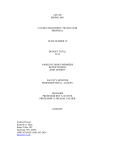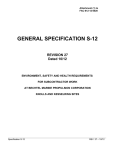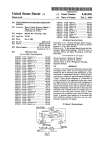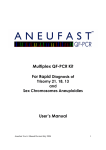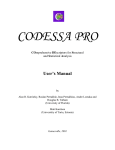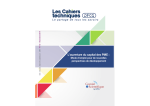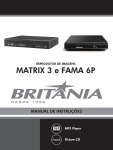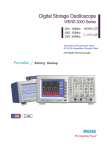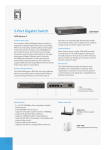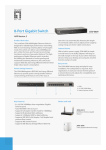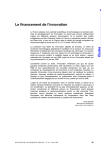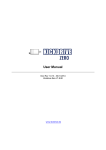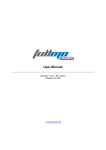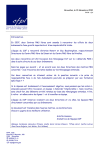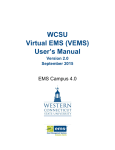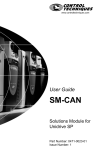Download CpE 180 SPRING 2001 CAN BUS DIAGNOSTIC TRANSLATOR
Transcript
CpE 180 SPRING 2001 CAN BUS DIAGNOSTIC TRANSLATOR PROPOSAL TEAM NUMBER 19 BUDGET TOTAL $180 NAMES OF GROUP MEMBERS KENNETH HECK JOHN MURPHY FACULTY MONITOR PROFESSOR WILS L. COOLEY SPONSORS PROFESSOR ROY S. NUTTER PROFESSOR G. MICHAEL PALMER 04/23/2001 Contact Person: Kenneth A. Heck Route 2 Box 182 Fairmont, WV 26554 (304) 363-6824; (304) 363-2814 [email protected] TABLE OF CONTENTS TABLE OF CONTENTS............................................................................................. 2 SECTION 1. INTRODUCTION .................................................................................. 3 SECTION 2. DESIGN OBJECTIVES ......................................................................... 5 2.1 Design Goals and Constraints...................................................................................................... 5 2.2 Design Specifications.................................................................................................................. 7 2.3 Deliverables................................................................................................................................ 8 2.4 Validation................................................................................................................................... 9 SECTION 3. SYSTEM DESCRIPTION .................................................................... 10 3.1 System Description ................................................................................................................... 10 3.2 Block Diagram.......................................................................................................................... 12 3.3 Data Flow Diagrams ................................................................................................................. 14 SECTION 4. ORGANIZATION AND PLANNING .................................................. 17 4.1 Scheduling................................................................................................................................ 17 4.2 Division of Responsibility ......................................................................................................... 18 SECTION 5. BUDGET.............................................................................................. 19 5.1 Budget ...................................................................................................................................... 19 5.2 Budget Justifications ........................................................................................................... 20 SECTION 6. QUALIFICATIONS ............................................................................. 21 6.1 Kenneth Alan Heck, MS ........................................................................................................... 21 6.2 John Murphy............................................................................................................................. 23 SECTION 7. REFERENCES ..................................................................................... 24 7.1 Notated References ................................................................................................................... 24 7.2 Other useful references.............................................................................................................. 24 SECTION 8. APPENDICES...................................................................................... 25 8.1 Supporting Information ............................................................................................................. 25 8.2 Additional Block Diagrams ...................................................................................................... 26 8.3 Determination of Flash Memory Requirements.......................................................................... 30 Team 19: CAN Bus Translator : Proposal : Introduction Page 3 of 30 SECTION 1. INTRODUCTION Throughout the 1970's and 80's, the electrical systems in automobiles dramatically increased in complexity and weight with the continuing addition of electrical devices such as sound systems and on-board computers, and with the increasing use of electrical systems for the control of systems that were previously purely mechanical, such as braking. These devices and systems required correspondingly sophisticated control and communications systems, especially as their role in the operation of the car became more central. These developments meant difficulty in the design and maintenance of new automobiles, and often meant that people could no longer repair their own cars. The devices themselves became heavy and complicated, and the opportunities for malfunction increased. In an effort to simplify the design and maintenance of new automobiles, the Controller Area Network (CAN) standard was invented at Robert Bosch GmbH (Reutlingen, Germany) in the late 1980's, and later the CAN 2.0 standard in September 1991.1 The problems they faced included the need for safety, the high-noise environment of a running automobile, and the need for flexibility and speed of high-fidelity communication among electrical devices in a car. The solution was a high-speed bus (Referred to as a CAN bus), the signals on which traveled on a pair of polarity-switching lines, and which was capable of extremely reliable performance.2 Adoption of the CAN standard by automobile manufacturers came eventually, but the technology found enthusiastic support in other and varied settings, including the fields of industrial automation and medical equipment. Each field that adopted the CAN Team 19: CAN Bus Translator : Proposal : Introduction Page 4 of 30 standard did so with its own small changes and refinements, to the degree that today some implementations have little in common.2 The Formula Lightning team at West Virginia University is one such user of the CAN standard. Led by Dr. Roy Nutter, the Formula Lightning team has devoted itself to the design and construction of a fully electric racecar. This car uses a CAN bus for the control and operation of its electrical systems. In order to ensure the correct and optimal operation of these systems, a means of access the bus must be devised. The bus must be accessible to them under both workshop and field conditions in order to diagnose and solve the various electrical problems that arise. Team 19: CAN Bus Translator : Proposal : Design Objectives Page 5 of 30 SECTION 2. DESIGN OBJECTIVES 2.1 Design Goals and Constraints The Formula Lightning team requires a device to perform the task of communication and control on their implementation of the CAN bus. This device must translate CAN signals to a standard signal that can be read by a technician with a laptop computer running a software package developed by Andy Pertl. The device must enable the technician to read signals on the bus, whether all the signals or only a selected set, and to write signals to the bus. While this alone is sufficient for workshop use, the nature of the application requires field testing – literally, while racing the car around a track – and so further constraints are placed on the operation of the device. Due to the economy of space in the Formula Lightning car, the device must operate without a technician's computer connected while the car is in motion. The device must itself, therefore, be small enough to not encumber the driver of the car or otherwise interfere with the car's normal operations. In order to be of use with this particular implementation of the CAN bus, the device must communicate according to the SAE standard described in J1939. This will enable it to correctly read a signal from a CAN bus line. The signals it must read and write to the bus may be either or both CAN 2.0A and CAN 2.0B, which are similar packet structures differing mainly in length. In order to communicate with the laptop computer, the device will communicate to the computer's COM port using the RS-232 standard, using the protocols accessed by Andy Pertl’s software package. A Team 19: CAN Bus Translator : Proposal : Design Objectives Page 6 of 30 microcontroller capable of Universal Asynchronous Receive/Transmit (UART) combined with a single-chip RS-232 device will be suitable for this function. The act of writing a signal to the bus requires that the device read the signal from the laptop, and package it correctly for CAN 2.0A and CAN 2.0B. This will require the microcontroller to assemble a full CAN packet (which is larger than the packets transmitted by the laptop) and construct the correct header depending on whether the packet is 2.0A or B. Once correctly packaged, the device will write the signal to the bus according to the arbitration methods defined in the CAN standard. The signal that the device writes may also be stored on the device in such a way that it can be "played back" onto the bus at a pre-determined time, or multiple times at predetermined intervals. This will enable the device to be used without an attached computer for a short period of time. In order to perform this task, there will be a series of pre-defined instructions that the device must recognize, accept, and process to regulate its own behavior and state. These signals will be defined in such a way that the device will be able to quickly distinguish them from signals that must be written to the CAN bus. In order to read from the bus, the device will take a signal in its entirety from the bus line, and determine whether the signal is wanted by the user. If the signal is wanted, the device will either divide it up to send to the attached computer via RS-232, or if a computer is not attached, store it for later playback. In playback mode, the device will communicate the stored signals in the order that they were received to the attached computer in such a way as to simulate the CAN bus's operation during the recorded time. This mode will be easily accessible to the user of the software, and removable storage media will allow multiple playbacks of various test runs. Team 19: CAN Bus Translator : Proposal : Design Objectives Page 7 of 30 2.2 Design Specifications Input Impedance: CAN-side: ................................................... 120Ω +/- 12Ω Device Power Requirements: Power Sources:............................................ External: 12V w/ shielded cable Current Draw:.............................................. <200mA Communications: CAN-side: ................................................... Max 1Mbit/sec PC-side:....................................................... Max 115.2Kbit/sec Communications Protocols: CAN-side .................................................... (1) CAN 1.x (2) CAN 2.0A (3) CAN 2.0B (Read Only) PC-side........................................................ RS-232 Connections: CAN-side .................................................... DB-9 CAN-side connector harness........................ (1) DB-9 to 5-pole (2) DB-9 to 6-pole (3) DB-9 to 9-pole PC-side........................................................ DB-9 PC-side connector harness ........................... (1) DB-9 to DB-9 (2) DB-9 to DB-25 Power .......................................................... 2.1mm barrel Operational Environment: Electrical Isolation....................................... Max 24V applied to case Shock (Force) .............................................. Max 4g Pressure....................................................... Max 60psi Water Resistance ......................................... 1ft submersible (or equivalent) Temperature:…………………..……………Between 0, 100 degrees Fahrenheit Dimensions (excluding external cabling): Case............................................................. 2.00” H x 5.00” W x 6.00” D (51mm H x 127mm W x 153mm D) Weight......................................................... 3.0 lbs (1.37 kg) PC Requirements: Must run CAN software written by Andy Pertl Programming Languages: PC:………………………………………….C or C++ PIC:…………………………………………PIC C, Assembly where needed Team 19: CAN Bus Translator : Proposal : Design Objectives Page 8 of 30 2.3 Deliverables The device, when finished, will consist of a box as described above -- no larger than 2"x4"x5", weighing not more than 3.00 pounds, with four openings. The first opening will allow a cable to connect the device to the CAN bus via DB-9. The second opening will be a DB-9 type socket for a cable connecting to a computer. This second opening will be pluggable to prevent entry of dirt, oil or water. The third opening will allow a power cord. The last opening will permit a flash memory card. This opening will also be sealable. The power cord and CAN bus cable will be provided with the device. The user must provide the cable connecting to the DB-9 socket. One flash memory card will be provided with the system. Additional cards of the same type may be used with this device, but purchase, storage, and care of these cards is solely the responsibility of the user. A manual will also be delivered containing detailed instructions of use and maintenance for the device, as well as a complete listing of all software code and circuit diagrams, with a complete listing of parts used. Repair directions will be given for parts more easily replaced, such as fuses. A sketch of the proposed product is attached in the appendices (Figure 5). Team 19: CAN Bus Translator : Proposal : Design Objectives Page 9 of 30 2.4 Validation In order to determine that the device works correctly, the following tests will be performed: The delivered device will be connected to a laptop computer and a working CAN bus. This same bus will have on it a similar device (of outside manufacture) for testing purposes. First, the system will be run so that the bus will carry signals from multiple sources. The device being tested will identify all of these signals and relay them. The signals relayed by the delivered device will be compared to those relayed by the outside device to ensure that all signals have been received, and no extraneous signals reported. This comparison will be done using two PCs running identical software, connected to the same bus, one with the delivered device and one with the outside device. The delivered device will then be instructed to send certain signals over the shared bus. The outside device’s output will be consulted to verify that these signals have been sent correctly. The delivered device will be given instructions by its PC to store all signals from a given source on the bus (Identified using a CAN numeric identifier) and then attached to a CAN bus without the computer attached. The system will be run so that the bus carries signals from this source for two minutes, then shut down, and the delivered device attached to a computer to relay the stored data. Lastly, the device will be used for a week at the test track under normal-use conditions, which may include accidental dropping or wetting. After this week, the device will be put through the above tests once more to ensure that no harm has come to it. Team 19: CAN Bus Translator : Proposal : System Description Page 10 of 30 SECTION 3. SYSTEM DESCRIPTION 3.1 System Description The device will be a single-board electronic device with a 12-volt DC power supply (external, drawing from automobile battery). It will contain a 40 MHz oscillator for a clock, and four microchips: A PIC microcontroller (likely the 16F877, referred to as "additional PIC" on the budget), Microchip's CAN bus controller MCP2510, a Max232 IC for RS-232 and an Intel 82527 for the CAN voltage conversion. Circuits for power conversion will be present, and a fuse will protect the circuit from power spikes. There will also be a socket for connecting a flash memory card. The PIC chips will handle the tasks of interfacing with the CAN bus, interfacing with the computer (via RS-232), storing information to the flash memory, receiving and executing instructions from the computer, and both determining then communicating error states. Microchip's CAN controller auto-detects certain errors and can "mask out" packets from certain sources. This controller will handle arbitration and communications on the CAN bus. Once the controller has received a full packet, it will pass it to the PIC, which can be programmed to either store it on the flash memory for later retrieval, or (by default) to break the packet into smaller portions and send them serially via RS-232. The device will activate immediately upon being plugged into a power source, and will have a sleep mode to conserve power when it is idle. The PC-side connection will be a female DB-9 connector, electrically isolated from the CAN bus. The CAN-side connection will be a male DB-9 connector. Both will be clearly marked to prevent confusion. The flash memory card will be connected via its Team 19: CAN Bus Translator : Proposal : System Description Page 11 of 30 proprietary connector. The power cable, which will be heavily insulated, will be attached using a 2.1mm barrel connector and clearly marked as “Power.” The program on the PIC will be done in PIC C, with inline PIC assembly for the speed-critical sections. Microchip's MPLAB software and header files will be used for programming the PIC. On the PC, Dynamically Linked Libraries (DLLs) provided by Andy Pertl will be used, most likely in conjunction with the Visual C++ and Visual Basic Studios, both designed for programming in the Windows 98 and Windows NT environments. All source code will be delivered in hard copy to Dr. Nutter with the manuals for the device, with compilation instructions. Team 19 : CAN Bus Translator : Block Diagrams Page 12 of 30 3.2 Block Diagram CAN CAN Parallel to Serial Generate CAN Header TTL (Control) Select Signal Serial to Parallel Error Detection Mask Out Unwanted Signals Time-Stamp TTL (Control) Control Lines (Control and Clock) Team 19 : CAN Bus Translator : Block Diagrams Page 13 of 30 Figure 1: CAN Bus Diagnostic Translator Block Diagram TTL Block NonMessage Packets RS-232 Strip Header (Processing) (Buffer/ Isolation) Control Interpret Control (Processing and Storage) TTL (Processing) TTL (Storage) Select Input According To Mode RS-232 Receive and Transmit Determine if Packet is Control or Message Generate RS-232 Header RS-232 (Buffer/ Isolation) Team 19 : CAN Bus Translator : Block Diagrams Page 14 of 30 3.3 Data Flow Diagrams CAN Bus CAN Signal CAN Signal Translate CAN to RS-232 Translate RS-232 to CAN RS-232 Signal RS-232 Signal PC via RS-232 Level 0 DFD Figure 2: Level 0 Data Flow Diagram Team 19 : CAN Bus Translator : Block Diagrams Page 15 of 30 CAN Bus CAN Signal CAN Signal Convert signal to TTL TTL to CANReady signal Raw TTL Signal Buffer 1 TTL Signal Raw TTL Signal Package TTL as RS-232 Remove RS-232 and form TTL Packet RS-232 Signal Buffer 2 RS-232 Signal RS-232 Signal Send RS-232 to PC Send RS-232 to CAN RS-232 Signal RS-232 Signal PC via RS232 Level 1 DFD Figure 3: Level 1 Data Flow Diagram Team 19 : CAN Bus Translator : Block Diagrams Page 16 of 30 Raw TTL Signal Buffer 1 Raw TTL Signal Error-check signal Error Signal Valid Signal Generate status and error signal Generate data packet Partial RS-232 Error Packet Partial RS-232 Data Packet Package RS-232 packet with proper parity Complete RS-232 Packet With Parity Buffer 2 Complete RS-232 Packet With Parity Level 2 DFD Figure 4: Level 2 Data Flow Diagram Team 19: CAN Bus Translator : Proposal : Organization and Planning Page 17 of 30 SECTION 4. ORGANIZATION AND PLANNING 4.1 Scheduling While the following Gantt chart assumes that all work will be done in the Fall semester, likely many of the tasks will be performed during the previous summer. Many of the tasks to be performed are self-evident – such as the purchase of parts. There are a few things on the Gantt chart that bear explanations. The chart refers to “PIC #2” in some tasks. This PIC is the “additional PIC” in the budget list, and takes much of the responsibility for the left-hand side of the block diagram, notably clock and control functions. As noted in the Deliverables section, only one manual will be produced, as per Dr. Nutter’s instruction. This manual will combine the documents normally referred to as the “user’s manual” and “service manual.” This combination is for his convenience and for a general reduction of redundancy in documentation. They are listed separately because of the nature of the work, even though they will at the end be combined into a single deliverable document. Lastly, the number/number notation is shorthand for the person responsible, in the order Heck/Murphy. Thus, 10/5 in a block represents Heck spending 10 hours and Murphy spending 5. A /3 in a block represents Murphy alone spending 3 hours. JM 5 1 5 0 5 20 10 10 40 0 5 5 10 3 5 10 10 10 154 KH 5 1 20 20 20 0 20 10 0 5 0 5 10 3 5 10 10 10 154 1) Design Circuit 1) Buy Parts 2) Learn to use and wire CANBus PIC 3) Program the CANBus PIC 4) Learn to use and wire PIC#2 5) Program PIC#2 6) Learn to use and wire memory card 7) Learn to use Andy Pertl’s software 8) Make changes to AP software 9) Design power supply 10) Learn to use and wire the serial port 11) Learn to etch boards 12) Learn to build/etch prototype board 13) Build case to meet specifications 14) Test project to ensure specifications 15) Service Manual 16) User’s Manual 17) Prepare for Design Fair TOTAL Task Effort 10/ 5 5/ 5/5 08/ 20 18/ 18 1/1 1/1 10/ 10 5/5 1/1 08/ 27 12/ 12 1/1 1/1 /10 10/ 09/ 03 12/ 12 1/1 1/1 /10 5/ 5/ 09/ 10 17/ 12 1/1 1/1 /10 15/ 09/ 17 12/ 17 1/1 1/1 /10 10/ 5 09/ 24 12/ 17 1/1 1/1 /5 /10 10/ 10/ 01 12/ 17 1/1 1/1 10/ 5 /10 10/ 08 Week 12/ 12 1/1 1/1 10/ 5 10/ 15 12/ 12 1/1 1/1 5/5 5/5 10/ 22 8/8 3/3 5/5 10/ 29 5/5 5/5 11/ 05 10/ 10 10/ 10 11/ 12 11/ 19 11/ 26 Team 19: CAN Bus Translator : Proposal : Organization and Planning Page 18 of 30 4.2 Division of Responsibility Team 19: CAN Bus Translator : Proposal : Budget Page 19 of 30 SECTION 5. BUDGET 5.1 Budget 1. CANBUS Controller – MCP2510 Project Cost $7 Proposal Cost $7 2. Additional PIC for other Functions $10 $10 3. PICStart Plus Programmer $150 $0* 4. MAX232A $5 $0** 5. Intel 82527 $9 $9 6. DB9 connector (Receptacle) $3 $3 7. DB9 connector (Plug) $3 $3 8. Circuit Board Etch Kit $30 $30 9. Capacitors, Resistors, Inductors $5 $5 10. Case (Aluminum) $15 $15 11. Power Connector (Receptacle) $1 $1 12. Power Connector (Plug) $4 $4 13. Oscillator $3 $3 14. IC Sockets $1 $0** 15. Flash Memory (32MB) $40 $40 16. Flash Socket $5 $5 17. DC-DC Converter $9 $9 18. Resettable Fuse $1 $1 19. Power Switch $5 $5 20. Any other discrete components $5 $5 21. Miscellaneous (solder, etc.) $5 $5 22. Shipping/Handling Charges TOTAL $20 $336 $20 $180 Requested from Sponsors=$80 Requested from CSEE Department=$100 ____________________________ Sponsor Signature Date ____________________________ Chair Signature Date ____________________________ Monitor Signature Date Team 19: CAN Bus Translator : Proposal : Budget Page 20 of 30 5.2 Budget Justifications 1. CANBUS Controller – MCP2510 Digi-Key # MCP2510-E/P-ND 2. Additional PIC for other Functions Digi-Key # PIC16F877-20/P-ND 3. PICStart Plus Programmer* Digi-Key # UP003001 4. MAX232A** Digi-Key # MAX232ACPE-ND 5. Intel 82527 Pioneer Std # AN82527F8 6. DB9 connector (Receptacle) Newark # H3R09RA29B 7. DB9 connector (Plug) Newark # H3M09RA29B 8. Circuit Board Etch Kit Newark # 00Z1482 10. Case (Aluminum) Newark # 95F939 11. Power Connector (Receptacle) Newark # 84N1192 12. Power Connector (Plug) Newark # 84N1158 13. Oscillator Newark # 95F8736 15. Flash Memory (32MB)*** Buy.com # SDCFB-32-455 16. Flash Socket*** Newark # 95B8852 17. DC-DC Converter Newark # 95B9538 18. Resettable Fuse Newark # 85F256 19. Power Switch Newark # 46F3056 * Provided by Kenneth A. Heck ** Donated by Kenneth A. Heck *** Compact Flash used for this budget, though a different flash memory may ultimately be utilized. Team 19: CAN Bus Translator : Proposal : Qualifications Page 21 of 30 SECTION 6. QUALIFICATIONS 6.1 Kenneth Alan Heck, MS Kenneth Alan Heck, MS Route 2 Box 182 Fairmont, WV 26554 Home Phone : (304) 363-6824 E-Mail: [email protected] Education : 01/98-Present: University : Coursework : West Virginia University, Morgantown, WV Pursuing BS in Computer and Electrical Engineering 08/96-12/96 : College : Registration : License : Santa Fe Community College, Gainesville, FL : EMT - B, December 1996 National Registry of Emergency Medical Technicians - #B1103946 West Virginia - #B-036323 08/92-02/96 : University : Thesis : Research Director : Graduate Coursework : Equipment Skills : Other Duties : 08/88-05/92 : University : Coursework : Special Topics Course : Equipment Skills : Honors/Scholarships : University of Florida, Gainesville, FL : MS, December 1995 "General Synthetic Methods for Alpha-hydroxy Ketones" Dr. Alan R. Katritzky, Kenan Professor, Center for Heterocyclic Compounds 1 sem. each : General Organic, Organic Synthesis, Organic Mechanism, Organic Spectroscopy, Inorganic, Organometallics, Quantum Theory 300MHz NMR's : Varian Gemini-300, VXR 300, GE QE-300; HPLC Katritzky group lab steward, miscellaneous equipment repair West Virginia University, Morgantown, WV : BA, Chemistry December 1992 Mostly BS and Honors courses, organic courses with microscale techniques X-Ray diffraction IR : Perkin-Elmer; PC-based systems (i) WVU Presidential Scholarship (ii) John A. Moore (Chemistry) Scholarship (iii) WVU Honors Program Experience : 01/00-Present : Business : Title : Functions: 08/97-12/99 : Employer : Title : Supervisor : Duties : Heck Solutions Owner Software Development specializing in Access 97 Custom-built PC’s/Upgrades PC Diagnosis/Repair West Virginia University, Financial Aid Office, Morgantown, WV 26506-6004 Information Systems Technician Tresa Weimer, Supervisor : (304) 293-8571 ; 1-800-344-WVUl System Administrator of Local Area Network running Novell Netware 4.11 Training employees to use software : Netware 4.11, Win 95, Win 98, WP6.1, FoxPro 2.6, BANNER 2.15, MS Office Pro 97 Maintenance and Repair: Various PC’s and Printers Developing need-specific software for varying uses in the office : Access 97 , FoxPro 2.6 Supervision of Work Study employees Team 19: CAN Bus Translator : Proposal : Qualifications Page 22 of 30 06/97-Present : Employer : Title : Supervisor : Duties : 06/96-02/97 : Employer : Title : Supervisor : Duties : 01/93-02/96 : Employer : Title : Supervisor : Duties : 08/88-07/92 : Employer : Title : Supervisor : Duties : 03/91-07/92 : Employer : Title : Supervisor : Duties : Monongalia General Hospital, 1200 JD Anderson Drive, Morgantown, WV 26505 Part-Time Monitor Tech Glenda Broad: (304) 598-1506 Watching 5 monitors capable of 8 strips each, paging nurses for dysrhythmias Recording and analyzing rhythm strips once per shift Tracking patient room assignments, notifying necessary personnel for admits/discharges Maintaining patient information board for physicians, nurses, administrative personnel Farchan Laboratories, 4906 NW 53rd Street, Gainesville, FL 32653 Bench Chemist - Research and Development Dr. Radi Awartani : (352) 374-6825 Running small (50mL) to large (22L) scale reactions as directed Supervising technicians in running reactions Quality control analysis by GC, HPLC, IR, Karl-Fischer water analysis, titration, melting point and refractive index Lab equipment maintenance University of Florida, Department of Chemistry, Gainesville, FL 32611 Graduate Research/Teaching Assistant Prof. Merle A. Battiste : (352) 392-0552 3 sem. General Chemistry, 2 sem. Organic Chemistry Lab West Virginia University, Financial Aid Office, Morgantown, WV 26506-6004 Clerical Assistant Brenda Thompson, Director : (304) 293-5242 ; 1-800-344-WVUl Clerical work : Filing, typing, answering phones, stocking, errands Developing need-specific software for varying uses in the office : FoxPro 2.0 LAN Training employees to use software : Netware 2.10, WP5.1, FoxPro 2.0, DOS PC Maintenance First National Bank of Morgantown, 201 High Street, Morgantown, WV 26505 (now Huntington Banks, WV) Part-Time Computer Operator Scot Epling, Assistant Vice President : (304) 367-2452 ; 1-800-377-BANK Unsupervised after hours final sorting of personal checks using a Honeywell DPS 6 Developing need-specific software : dBase IV 1.1 and QuickBasic Software installation : WP5.1, Lotus, PCTools Diagnosing and correcting PC hardware problems Publication : A. R. Katritzky, K. A. Heck, J. Li, A. Wells, C. Garot, "1-(1-Alkenyl)benzotriazoles: Novel Equivalents for the Synthesis of α-Hydroxy Ketones", Synth. Commun., 26(14), 2657-2670. (1996) Team 19: CAN Bus Translator : Proposal : Qualifications Page 23 of 30 6.2 John Murphy John Murphy 910 Montrose Ave Morgantown, WV 26505 (304)292-8870 [email protected] Resume Objectives: To obtain a graduate degree in electrical engineering in the particular field of robotics. To gain experience designing, building, controlling, and maintaining robotic systems. Job Experience: Intern, NASA IV&V Summer, 1996 Fairmont, WV (Funded by George Washington University) Involved with SORT (Software Optimization and Reuse Technology) project, a software engineering effort as related in particular to Marshall Space Flight Center's flight furnace project. Oral demonstrations of progress given both to peers and superiors at the end of the internship Math tutor, West Virgina University Math Department Morgantown, WV Aug 2000 - present Education: West Virginia University 1997-present Morgantown, WV (Expected graduation date: Dec 2001) Degrees to be received: BSCpE, BSEE, emphasis in control systems Morgantown High School Morgantown, WV 1994-1997 Skills: Programming (Windows, MS-DOS and UNIX environments): C, Java, Intel x86 assembly, PIC assembly, PIC C, Ada, Matlab, Perl, Lisp Spoken and Written Japanese Use of fuzzy logic and genetic algorithm techniques, particularly in control applications Experience designing with and programming for PIC chips Team 19: CAN Bus Translator : Proposal : References Page 24 of 30 SECTION 7. REFERENCES 7.1 Notated References 1) CAN Specification, Version 2.0, Robert Bosch GmbH, Postfach 50,D-7000, Stuttgart 1, 1991. 2) 7.2 Other useful references 1) IC Microcontrollers, Peatman, John B., Prentice Hall, New Jersey, 1998. 2) KVASER Controller Area Network pages : http://www.kvaser.com/can/index.htm 7.2.3 Websites 1) AnyBus Official Site : http://www.hms.se/ 2) CAN in Automation : http://www.can-cia.de/ 3) Dearborn Group, Inc. : http://www.dgtech.com/products/dpa.phtml 4) DeviceNet-ODVA Official Website : http://www.odva.org/10_2/00_fp_home.htm 5) International Organization for Standardization homepage : http://www.iso.ch/ 6) OSEK/VDX : http://www.osek-vdx.org/ 7) Triangle Data : http://www.triangledigital.com/products/productscanbus.htm 8) Wesley Tang's Can Links : http://www.warwick.ac.uk/~esrpy/links.htm 9) Zanthic Products : http://www.zanthic.com/can4usbm.htm Team 19 : CAN Bus Translator : Block Diagrams Page 25 of 30 SECTION 8. APPENDICES 8.1 Supporting Information Figure 5: Sketch of CAN Bus Diagnostic Translator Team 19 : CAN Bus Translator : Block Diagrams Page 26 of 30 8.2 Additional Block Diagrams Power CAN RS-232 Translator Device RS-232 CAN Buffer/Storage Figure 6. General Block Diagram Team 19: CAN Bus Translator : Proposal : Appendices Page 27 of 30 CAN CAN CAN to TTL/ TTL to CAN Processing TTL TTL to RS-232/ RS-232 to TTL TTL TTL TTL RS-232 RS-232 Control Control Lines Clock Storage Buffer/Storage Figure 7. Expanded Block Diagram Buffer/Isolation Power RS-232 RS-232 RS-232 Transmit/ Receive RS-232 RS-232 Team 19: CAN Bus Translator : Proposal : Appendices Page 28 of 30 CAN CAN Parallel to Serial Serial to Parallel Generate CAN Header TTL (Control) Error Detection Select Signal Mask Out Unwanted Signals Time-Stamp TTL (Control) Control Lines (Control and Clock) Figure 8. Detailed Block Diagram of Processing Team 19: CAN Bus Translator : Proposal : Appendices Page 29 of 30 TTL (Processing) Control RS-232 Block NonMessage Packets Strip Header Interpret Control Signal Determine Nature Of Packet Select Input According To Mode Generate RS-232 Header (Buffer/ Isolation) (Processing and Storage) TTL (Processing) TTL (Storage) Figure 9. Detailed Block Diagram of Control RS-232 (Buffer/ Isolation) Team 19: CAN Bus Translator : Proposal : Appendices Page 30 of 30 8.3 Determination of Flash Memory Requirements CAN Bus Maximum Data Rate: 1Mbit/sec (~125KBytes/sec) Assume 15 minutes of run time for a test run of the Formula Lightning Vehicle. 15 minutes * 60 sec/1 min = 900 sec. 900 sec * 125KBytes/sec = 112.5 MBytes Assuming a 25% ‘duty cycle’ on the CAN BUS, where the ‘duty cycle’ is a combination of the bus not being utilized at 100% capacity and messages being filtered before storage: 112.5 MBytes * 0.25 = 28.125 MBytes. So, a 32 MByte memory card should be sufficient for most test runs.






























